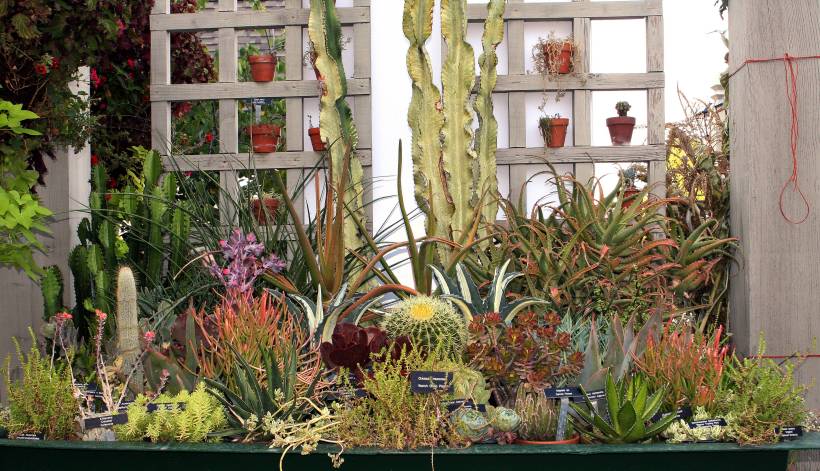Succulent plant
In botany, succulent plants, also known as succulents or sometimes fat plants, are plants having some parts that are more than normally thickened and fleshy, usually to retain water in arid climates or soil conditions. Succulent plants may store water in various structures, such as leaves and stems. Some definitions also include roots, so that geophytes that survive unfavourable periods by dying back to underground storage organs may be regarded as succulents. In horticultural use, the term “succulent” is often used in a way which excludes plants that botanists would regard as succulents, such as cacti. Succulents are grown as ornamental plants because of their striking and unusual appearance.
Definition
There are a number of somewhat different definitions of the term succulent. One difference lies in whether or not roots are included in the parts of a plant which make it a succulent. Some authors include roots, as in the definition “plants in which the leaves, stem or roots have become more than usually fleshy by the development of water-storing tissue.”[1] Others exclude roots, as in the definition “a plant with thick, fleshy and swollen stems and/or leaves, adapted to dry environments”.[2] This difference affects the relationship between succulents and “geophytes” – plants that survive unfavourable seasons as a resting bud on an underground organ.[3] These underground organs, such as bulbs, corms and tubers, are often fleshy with water-storing tissues. Thus if roots are included in the definition, many geophytes would be classed as succulents.
Plants adapted to living in dry environments are termed xerophytes; thus succulents are often xerophytes. However, not all xerophytes are succulents, since there are other ways of adapting to a shortage of water, e.g. by developing small leaves which may roll up or having leathery rather than succulent leaves.[4] Nor are all succulents xerophytes, since plants like Crassula helmsii are both succulent and aquatic.[5]
Those who grow succulents as a hobby use the term in a different way to botanists. In horticultural use, the term succulent regularly excludes cacti. For example, Jacobsen’s three volume Handbook of Succulent Plants does not cover cacti,[6] and “cacti and succulents” is the title or part of the title of many books covering the cultivation of these plants.[7][8][9] However, in botanical terminology, cacti are succulents.[1] Horticulturists may also exclude other groups of plants, e.g. bromeliads.[10] A practical, but unscientific, horticultural definition is “a succulent plant is any desert plant that a succulent plant collector wishes to grow”.[11] Such plants less often include geophytes (in which the swollen storage organ is wholly underground) but do include plants with a caudex,[12] which is a swollen above-ground organ at soil level, formed from a stem, a root or both.[3]
A further difficulty is that plants are not either succulent or non-succulent. In many genera and families there is a continuous sequence from plants with thin leaves and normal stems to those with very clearly thickened and fleshy leaves or stems, so that deciding what is a succulent is often arbitrary. Different sources may classify the same plant differently.[13]
Appearance
The storage of water often gives succulent plants a more swollen or fleshy appearance than other plants, a characteristic known as succulence. In addition to succulence, succulent plants variously have other water-saving features. These may include:
- Crassulacean acid metabolism (CAM) to minimize water loss
- absent, reduced, or cylindrical-to-spherical leaves
- reduction in the number of stomata
- stems as the main site of photosynthesis, rather than leaves
- compact, reduced, cushion-like, columnar, or spherical growth form
- ribs enabling rapid increases in plant volume and decreasing surface area exposed to the sun
- waxy, hairy, or spiny outer surface to create a humid micro-habitat around the plant, which reduces air movement near the surface of the plant, and thereby reduces water loss and creates shade
- roots very near the surface of the soil, so they are able to take up moisture from very small showers or even from heavy dew
- ability to remain plump and full of water even with high internal temperatures (e.g. 52 °C or 126 °F)[14]
- very impervious outer cuticle (skin)[14]
- mucilaginous substances, which retain water abundantly[14]

